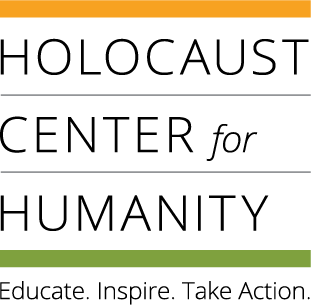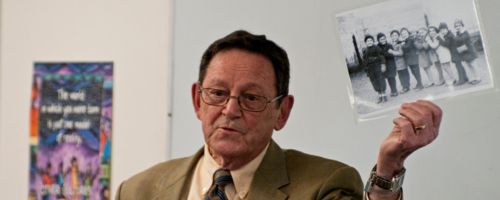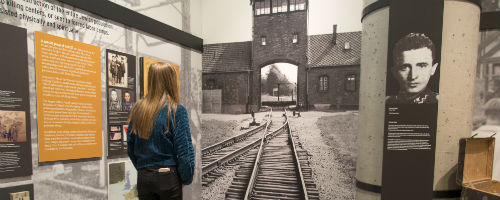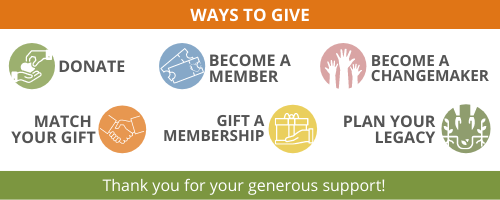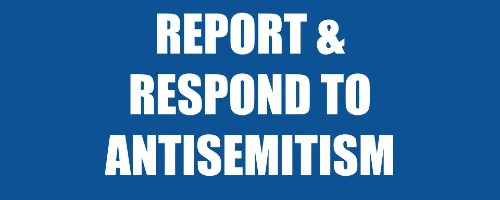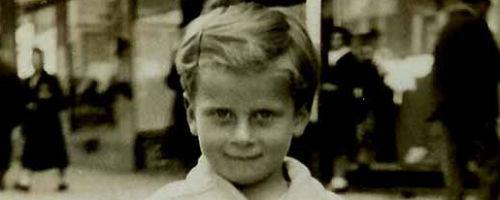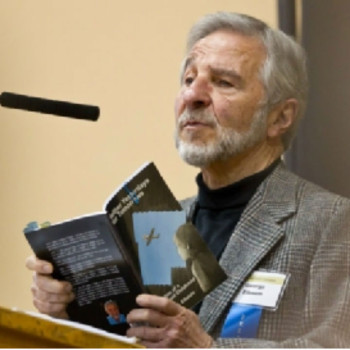
 George Elbaum was born in Warsaw, Poland on August 20, 1938, one year before Hitler invaded Poland and spurred the outbreak of World War II. Within weeks, George's father was called to serve in the army and never returned. Acutely aware of the danger she and her son were in, George's mom dyed her hair blonde and purchased the identification documents of a Catholic woman who had died. In 1942, she smuggled George out of the Warsaw ghetto before paying various Polish Catholic families to hide and raise him. In 1945, George was reunited with his mother, the only other surviving member of his family. They immigrated to America in 1949.
George Elbaum was born in Warsaw, Poland on August 20, 1938, one year before Hitler invaded Poland and spurred the outbreak of World War II. Within weeks, George's father was called to serve in the army and never returned. Acutely aware of the danger she and her son were in, George's mom dyed her hair blonde and purchased the identification documents of a Catholic woman who had died. In 1942, she smuggled George out of the Warsaw ghetto before paying various Polish Catholic families to hide and raise him. In 1945, George was reunited with his mother, the only other surviving member of his family. They immigrated to America in 1949.
For 60 years, George was reluctant to share his story with anyone. He worked towards an engineering career, earning an undergraduate degree, two Master's Degrees, and a Ph.D. from the Massachusetts Institute of Technology (MIT). In 2009, upon viewing "Paper Clips," a documentary chronicling a Tennessee middle school's unique attempt to honor Holocaust victims, George was moved to share his story with the world. He and his wife Mimi Jensen live in San Francisco, but George makes frequent trips to Seattle to visit his children and grandchildren. George is a member of the Holocaust Center's Speakers Bureau.
“I recognize that we who survived the Holocaust have a responsibility to tell our stories to give hope to the slogan ‘Never Again.’” - George Elbaum
Survivor Encyclopedia: Washington State - George Elbaum. Read more about George Elbaum, view photos of George and his family, and watch video clips.
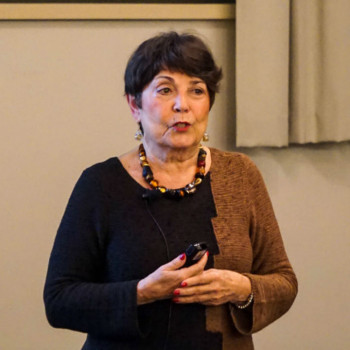
 “I was hidden with a Catholic family, a couple [with] no children. They pretended I was a cousin from the countryside."
“I was hidden with a Catholic family, a couple [with] no children. They pretended I was a cousin from the countryside."
-Agi Day
Agi Day (nee Zagorka Herzog) was born in Belgrade, Yugoslavia (now Serbia) in May 1940. Her family, being Jewish, escaped to Hungary when she was a baby, and during the last nine months of World War II Agi was hidden by Catholic people who posed her as one of their own.
In 1946, the growing threat of Communism again forced Agi and her family to flee. They escaped Hungary and then lived in several Displaced Persons camps in Austria.
In 1951 at age 11, Agi joined her mother in Toronto, Ontario, where she grew up and then became a teacher. She taught elementary school and English as a Second Language in the Toronto schools until she moved to Montreal, Quebec. In Montreal she raised her children while studying French, and was active in numerous community organizations. 10 years later, Agi and her family moved to Seattle, where she continued her volunteer
activities and went back to school to get a Master’s degree in Organizational Communication.
Later , Agi pursued a career in real estate for about 15 years on Mercer Island. She is now retired but still involved as a volunteer for different organizations. Since 2014, Agi has spoken to schools and community groups about her experiences during the Holocaust as a member of the Holocaust Center Speakers Bureau.
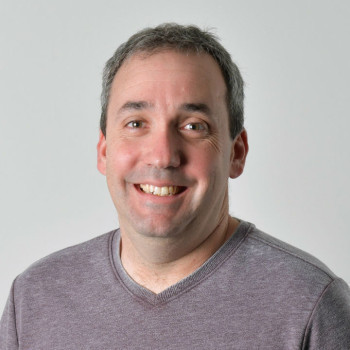
 Grandchild of four Holocaust survivors, Arik Cohen tells their stories of perseverance, luck, and resilience while calculating the incredible odds of their survival.
Grandchild of four Holocaust survivors, Arik Cohen tells their stories of perseverance, luck, and resilience while calculating the incredible odds of their survival.
Arik's maternal grandparents, Arye Schneider and Masha Klein, were born in Lithuania. Arye was born in Šaukėnai (Shukyan), Lithuania, where in 1941 nearly the whole Jewish population was murdered. Arye escaped and made his way to the Siauliai (Shavli) ghetto, where he met his wife Masha, a teacher who hailed from Neverenai (Nevaran). After the Shavli Ghetto massacre in November 1943, Arye and Masha hid in the woods for eight months until the Soviet Army liberated Lithuania.
Arik's paternal grandparents were from the Transylvania region in Romania. His grandfather Emil Kohn grew up in Suplac, while his grandmother Eva Hirsch was from Gherla. In May 1944, Emil and Eva were in Oradea when the ghetto was formed along with 35,000 other Jews, and not long after they were both deported to Auschwitz. After being separated upon arrival at Auschwitz, Eva was then sent to Stutthof to be used as slave labor, until she was forced on a death march in January 1945 and eventually liberated by the Soviet Army. Emil was liberated from Buchenwald in April of 1945 and found his way back to Eva.
Amazingly, both couples ended up living in the small beach town of Nahariya, Israel, and two of their children (Arik's parents) met and married. Today Arik lives in Bellevue, works at Microsoft, and shares his grandparents' stories.
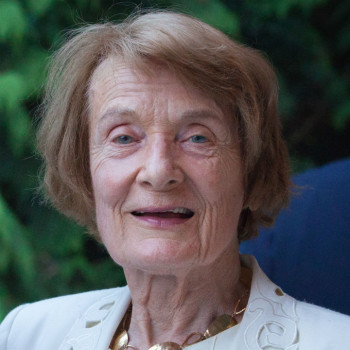
 Andrea and Joanna D’Asaro and their mother Barbara Sachs D’Asaro tell the story of Barbara’s childhood in Nazi Germany, and her escape as a young girl.
Andrea and Joanna D’Asaro and their mother Barbara Sachs D’Asaro tell the story of Barbara’s childhood in Nazi Germany, and her escape as a young girl.
Barbara was born Bärbel Sachs near Rostock, Germany on August 18, 1927. She was adopted by a Jewish couple, Erich and Johanna Sachs, who lived in Berlin.
When Hitler came to power in 1933, the Nazi regime made life increasingly difficult for Jews in Germany. As a result, Barbara’s parents bribed official s to destroy documents about her adoption, which noted that a non-Jewish child had been adopted into a Jewish family. Barbara lived a happy childhood as her parents attempted to protect her from the growing danger they faced. Despite their best efforts, Barbara was still exposed to Nazi propaganda. She experienced the rapid takeover of Nazi ideology and policies into everyday life, including schools and youth organizations.
With the escalation of persecution in Germany, Barbara’s parents decided that for their family’s safety, it would be best to leave the country. Although Barbara’s status, being non-Jewish by birth, may have been safe, her parents’ certainly was not. They were able to find two sponsors in New York City who would support them in their move to the United States.
The Sachs family arrived by ship in New York harbor in 1938 and began to build a life in New York City. Barbara attended Oberlin College in Ohio and later Cornell University. At Cornell, Barbara met her future husband Arthur D’Asaro, and they married in 1953. Barbara and Arthur had four children. Barbara used a master’s degree in Nutrition to direct health oriented classes, and Arthur used his doctorate in physics in his job at Bell Laboratories in New Jersey. Barbara’s parents had some relatives who scatter ed all over the world due to the Holocaust, and others who were murdered by the Nazis.
In 2017 Andrea, a teacher, helped Barbara put her family story together into a presentation for classrooms. With the help of the Holocaust Center, Barbara, Joanna, and Andrea are now part of the Speakers Bureau to share Barbara’s unique experience during World War II.
